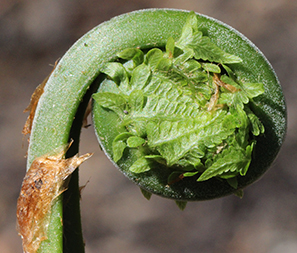Below is the first page from the Wild Edible Plant of the Month Club ID Sheet for Ostrich Fern, which is a fantastic and easy to identify wild edible plant available across all of North America.

Considered a rite of spring in Maine, the harvest of wild Ostrich Fern fiddleheads is a tradition deeply rooted in America’s Northeast. Fortunately, the Ostrich Fern grows throughout much of the eastern and northern states, as well as all throughout Canada. It can also be planted as an “edible ornamental” in almost any landscaping, as long as shade and water are monitored. (This is something I HIGHLY recommend.)
I have made a concerted effort, over the years, to curate quite a selection of edible landscaping plants around my home, and the Ostrich Fern outnumbers every other plant by at least double. I feast on fiddleheads for weeks every spring by simply stepping out on my front porch and harvesting my landscaping!

“Fiddlehead” is, of course, a term that refers to the tightly furled frond that resembles the ornate head of a fiddle. This fiddle and the stem below it is edible. Fiddleheads can be harvested until they unfurl, but they are best when tightly packed. The stem is some of the best eating, so be sure to harvest that as well. The average size at time of harvest is typically between 2 and 6 inches in length, from the top of fiddle to the bottom of stem.
When identifying the Ostrich Fern, there are five main features to check:
- There is a deep “U” shaped gutter in the middle of the inward facing side of the leaf stem.
- The stems are smooth and hairless, NOT fuzzy or hairy.
- Look for presence of the fertile spore-bearing fronds that grow erect in the middle of the plant. Although they aren’t present on every plant, they will be present on some of the plants nearby. These will typically be brown in color and remain, even throughout the winter. They are often still standing from the previous season when the fresh fiddleheads emerge.
- Both ends of the fern frond taper and the leaflets at the base of the leaf are very small (usually 1-inch or less).
- The newly emerging fiddleheads are covered with a tan, papery sheath.
The compound fern leaves can grow to be four feet long and are one of the most beautiful leaves in the forest. In fact, I’ve recently pressed a few between two weighted boards that I plan to frame and hang in my living room.

Ostrich Ferns are dimorphic, which means they have two forms of leaves. The first is the large green Ostrich frond that everyone associates with the plant. This one is the sterile leaf. The second is the smaller, thicker, erect frond that grows in the center of some (not all) plants. While the other leaves wither away, these erect fertile spore-bearing fronds can be found all through the summer, fall, and winter.
Like learning how identify & cook with Wild Edible Plants? Consider joining us over at http://www.wildedibleplantofthemonth.com. Download the FREE FORAGING CALENDAR by clicking the link below.

Remember, it’s not IF but WHEN,
Creek










No Comments